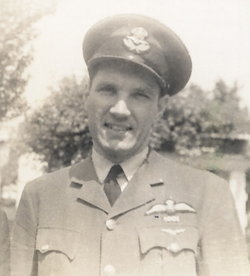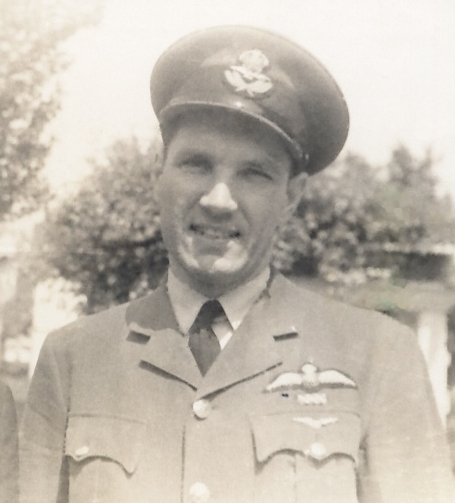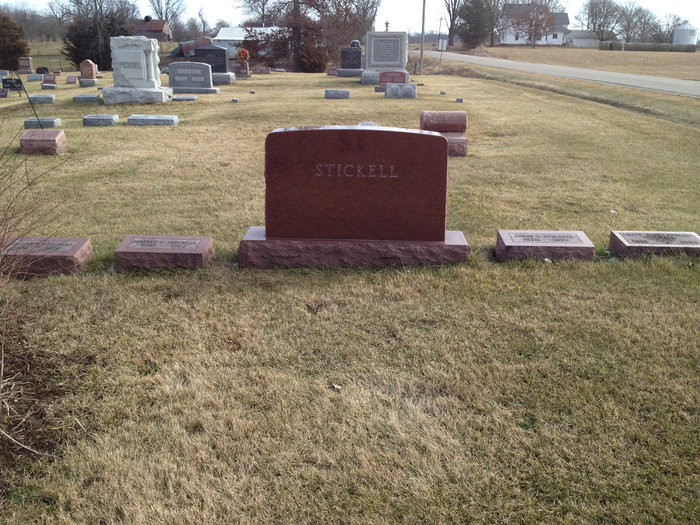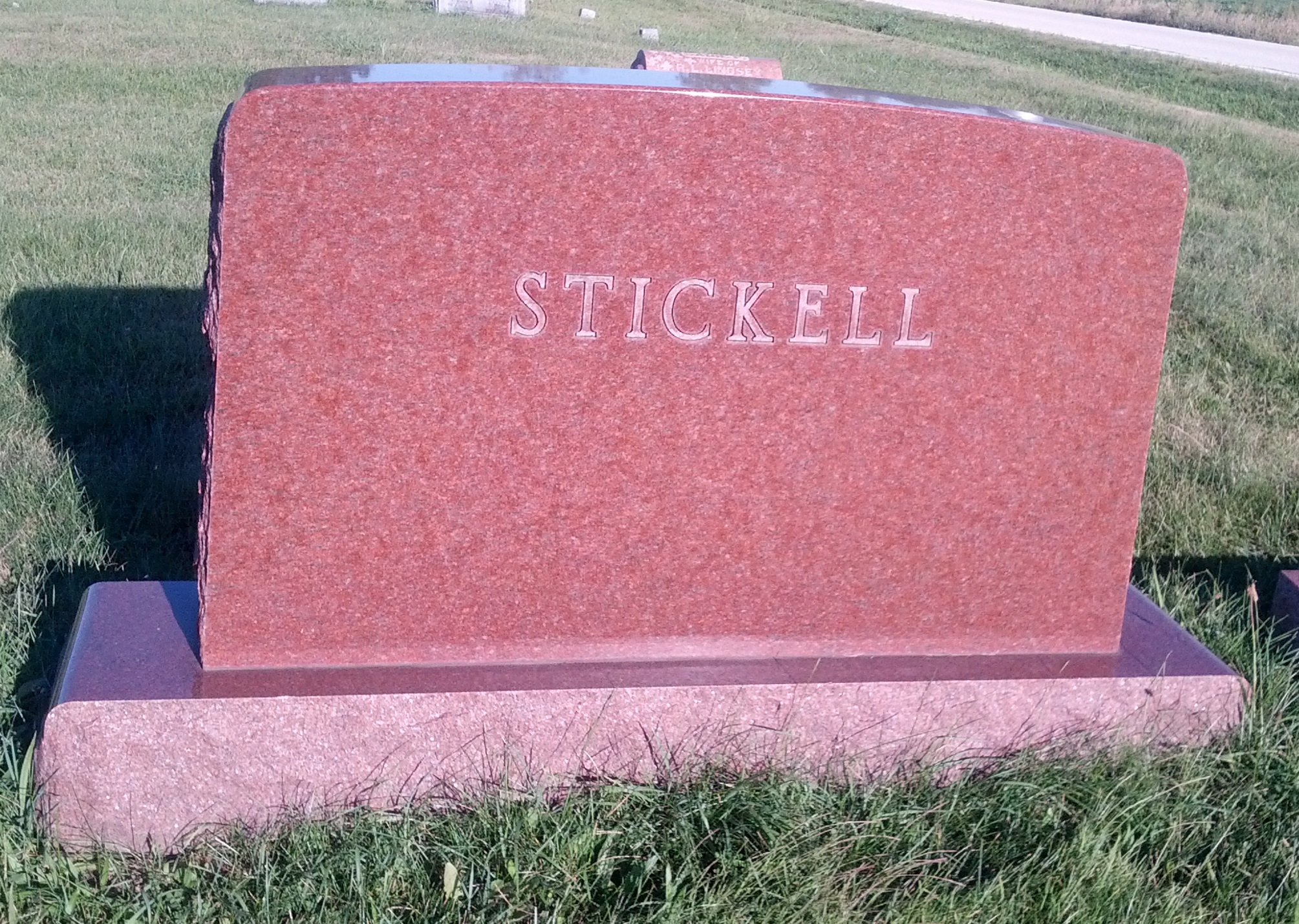(excerpts from Canada’s Aces by Hugh Kemp, Contemporary Publishers, 1944)
"John Stickell was a farm boy from Gilson, Illinois, who in his twenty-nine years flew over much of the earth’s surface, repaired tractors, did farm chores, went hunting with the English nobility, said “Gosh!” to the King of England, and saw the cities of Europe burning beneath his wings.
Stickell was a big, fellow, six foot two, and hundred and eighty-five pounds. He had dark hair, dark eyes, an easy-going manner. He was proud of America, yet intensely loyal to England. When the American fliers arrived in Britain, he was heard ‘defending “those Americans” against the accusations of “we British.”
He had the energy of his race and something of the gift for expression, but both characteristics were "manifested quietly and courteously. When he was interviewed by American newsmen they found him guilty of the British habit of under-statement.
John Stickell had many friends in England; fliers of a dozen widely-spread squadrons, army men, writers, government officials, old people and young children. One of his best friends was his navigator, a Montreal boy named Harry Shapiro, who flew with him on forty-four raids. People liked John.
Like most Americans Stickell knew a good time from a bad one. His leaves ranged from the Savoy in London to a small inn in Scotland and dissipated vast amounts of flying pay. These leaves also took in hunting at Lady Astor’s estate, Clivedon, where John was confused by the beaters and never hit anything.
Stickell enlisted in the R.C.A.F. at Windsor, Ontario, in late 1940; started training in ’.41. He was not a particularly brilliant student, either on the ground or in the air. He had great difficulty with the slow roll: “I get turned over and then have to get the book to see what to do next.” “In general he found that “flying was sort of tricky, but I never doubted I’d make it.” [His letters show the same self-deprecating humor—LS]
He spent a year on ops as an R.C.A.F. pilot with the R.A.F. [British Royal Air Force], making forty-eight sorties over Europe. His first few trips were on Wellingtons, the rest on four-engined Stirlings, B for Beer, B for Beer II, and K for King. B for Beer came to a sad end when Stickell undershot the runway; had to go up again and come in for a belly landing. When the Pathfinder Force was made up he applied and was accepted; subsequently led the bomber fleets to most of the main targets in Germany and Italy.
His first raid was made under unusual circumstances. He was at a four-engine conversion school when he was suddenly called back to the station where he had taken twin-engine, operational training. From this station he flew on the first of the thousand-plane raids—in the same plane he had used in training. The, RAF had to dig deep for its mighty smash against Cologne.
Stickell always thought flying the best thing a man could do. On his first raids he was appalled by the flaming destruction the bombers caused in enemy cities, but shortly came to accept this and even to desire it. Throughout he never lost his sheer love of flying. He continued to be impressed by the beauty of flight: “It was full moonlight when we saw Lake Geneva and the Swiss town of Geneva, the first city we had seen with lights in many months. Then we went past the snowy peaks of Montblanc and the Matterhorn, crossed long ridges and over deep valleys where we could see the lights of little villages in the depths. It was the most beautiful sight I’ve ever seen in my life.” .
All raids are tough, but John Stickell flew on some that are tougher than most. Perhaps his toughest was his second raid, against Essen. On this flight he looped a Wellington (disastrous manoeuvre) with full bomb load, to shake a night fighter, then fell two thousand feet out of control. Later, over target, his instruments were shot away. A short while after this his navigator saw a fighter coming in, but his tongue was paralyzed for the moment and he couldn’t notify John. Instead he grabbed the control column and threw the ship into a steep dive. Stickell, thinking chap hysterical, fought with him and attempted to level the aircraft. When the fighter blazed past the situation became apparent and peace was restored. By this time they were down to five hundred feet, so went right down on the deck and crossed the channel and coast at zero feet.
When approaching landing Stickell discovered how badly shot up the plane really was; it had no flaps and no brakes. He finally put down onto a fighter field; spun the length of the runway at a terrific clip and bounced off into an apple orchard. They ended up amongst amongst the trees; found no apples.
John Stickell’s youth was filled with mechanics. He looked after all the machinery on his family’s farm; generally had a car or motorcycle in bits and pieces. Each year he went to the Indianapolis Speedway Races and ate his heart out watching the participants.
In high school he managed to pass without much studying, made a reputation on the basketball court, and spent most of his after-school hours working on the farm. Later he put in four years at the Caterpillar Tractor Company in Peoria, assembling motors.
To the end of his days John Stickell remained a farm boy. He even described flying in farm similes: “The sky was full of planes . . . just a pell mell race like cattle coming in out of the lower pasture when the truck goes out with some food concentrate.” A long dive he made in a Stirling to avoid a trap over the Rhine River was “Like a high dive I made in the old swimming hole when I went through the water and up to my shoulders in mud.”
Stickell made his last raid with the R.C.A.F. on March 27th, 1943, against Berlin. This completed his second tour and finished his flying period. But John wasn’t content to leave the air and arranged a transfer to the American Navy, who agreed to let him go on flying.
He returned to America by ship, alternating between being sea sick and reading Victory Through Air Power. He then spent a month in Washington discussing R.A.F. methods with American officials.
Subsequently he went to a training station for familiarization with American Naval aircraft, and then on to a station in the Pacific.
Early in 1944 he went on a raid against an enemy base and his machine was slightly damaged. On landing several hours later John went to the hospital with a foot wound. Five days later complications set in, and to John Stickell-one of the great fliers of the war, death came quietly."
After John's death the important airfield captured from the Japanese at Eniwetok in the Marshall Islands was renamed Stickell Field in his honor. He was one of the first American Naval officers to wear three pairs of wings.
Medals
Royal Air Force (Great Britain)
Distinguished Flying Cross (DFC)
Distinguished Service Order (DSO)
Pathfinder Force Wings (3 sets)
United States Navy
Navy Cross
Distinguished Flying Cross
Air Medal
Purple Heart (Washington)
Purple Heart (South Pacific)
Victory Medal
South Pacific Campaign Medal
Peoria Man of the Year
Airfield on Eniwetok, Marshall Islands, renamed Stickell Field in his honor
Navy Destroyer U.S.S. Stickell (DD-888 / DDR-888) named in his honor
Not included through links below are John's sisters:
Susan Belle Stickell, 3 May 1911 - Jun 1972
Rose Madeline Van de Loo, 27 Jun 1918 - 27 Feb 2010
Helen Louise, 10 Jan 1920 - 11 Aug 1964
(excerpts from Canada’s Aces by Hugh Kemp, Contemporary Publishers, 1944)
"John Stickell was a farm boy from Gilson, Illinois, who in his twenty-nine years flew over much of the earth’s surface, repaired tractors, did farm chores, went hunting with the English nobility, said “Gosh!” to the King of England, and saw the cities of Europe burning beneath his wings.
Stickell was a big, fellow, six foot two, and hundred and eighty-five pounds. He had dark hair, dark eyes, an easy-going manner. He was proud of America, yet intensely loyal to England. When the American fliers arrived in Britain, he was heard ‘defending “those Americans” against the accusations of “we British.”
He had the energy of his race and something of the gift for expression, but both characteristics were "manifested quietly and courteously. When he was interviewed by American newsmen they found him guilty of the British habit of under-statement.
John Stickell had many friends in England; fliers of a dozen widely-spread squadrons, army men, writers, government officials, old people and young children. One of his best friends was his navigator, a Montreal boy named Harry Shapiro, who flew with him on forty-four raids. People liked John.
Like most Americans Stickell knew a good time from a bad one. His leaves ranged from the Savoy in London to a small inn in Scotland and dissipated vast amounts of flying pay. These leaves also took in hunting at Lady Astor’s estate, Clivedon, where John was confused by the beaters and never hit anything.
Stickell enlisted in the R.C.A.F. at Windsor, Ontario, in late 1940; started training in ’.41. He was not a particularly brilliant student, either on the ground or in the air. He had great difficulty with the slow roll: “I get turned over and then have to get the book to see what to do next.” “In general he found that “flying was sort of tricky, but I never doubted I’d make it.” [His letters show the same self-deprecating humor—LS]
He spent a year on ops as an R.C.A.F. pilot with the R.A.F. [British Royal Air Force], making forty-eight sorties over Europe. His first few trips were on Wellingtons, the rest on four-engined Stirlings, B for Beer, B for Beer II, and K for King. B for Beer came to a sad end when Stickell undershot the runway; had to go up again and come in for a belly landing. When the Pathfinder Force was made up he applied and was accepted; subsequently led the bomber fleets to most of the main targets in Germany and Italy.
His first raid was made under unusual circumstances. He was at a four-engine conversion school when he was suddenly called back to the station where he had taken twin-engine, operational training. From this station he flew on the first of the thousand-plane raids—in the same plane he had used in training. The, RAF had to dig deep for its mighty smash against Cologne.
Stickell always thought flying the best thing a man could do. On his first raids he was appalled by the flaming destruction the bombers caused in enemy cities, but shortly came to accept this and even to desire it. Throughout he never lost his sheer love of flying. He continued to be impressed by the beauty of flight: “It was full moonlight when we saw Lake Geneva and the Swiss town of Geneva, the first city we had seen with lights in many months. Then we went past the snowy peaks of Montblanc and the Matterhorn, crossed long ridges and over deep valleys where we could see the lights of little villages in the depths. It was the most beautiful sight I’ve ever seen in my life.” .
All raids are tough, but John Stickell flew on some that are tougher than most. Perhaps his toughest was his second raid, against Essen. On this flight he looped a Wellington (disastrous manoeuvre) with full bomb load, to shake a night fighter, then fell two thousand feet out of control. Later, over target, his instruments were shot away. A short while after this his navigator saw a fighter coming in, but his tongue was paralyzed for the moment and he couldn’t notify John. Instead he grabbed the control column and threw the ship into a steep dive. Stickell, thinking chap hysterical, fought with him and attempted to level the aircraft. When the fighter blazed past the situation became apparent and peace was restored. By this time they were down to five hundred feet, so went right down on the deck and crossed the channel and coast at zero feet.
When approaching landing Stickell discovered how badly shot up the plane really was; it had no flaps and no brakes. He finally put down onto a fighter field; spun the length of the runway at a terrific clip and bounced off into an apple orchard. They ended up amongst amongst the trees; found no apples.
John Stickell’s youth was filled with mechanics. He looked after all the machinery on his family’s farm; generally had a car or motorcycle in bits and pieces. Each year he went to the Indianapolis Speedway Races and ate his heart out watching the participants.
In high school he managed to pass without much studying, made a reputation on the basketball court, and spent most of his after-school hours working on the farm. Later he put in four years at the Caterpillar Tractor Company in Peoria, assembling motors.
To the end of his days John Stickell remained a farm boy. He even described flying in farm similes: “The sky was full of planes . . . just a pell mell race like cattle coming in out of the lower pasture when the truck goes out with some food concentrate.” A long dive he made in a Stirling to avoid a trap over the Rhine River was “Like a high dive I made in the old swimming hole when I went through the water and up to my shoulders in mud.”
Stickell made his last raid with the R.C.A.F. on March 27th, 1943, against Berlin. This completed his second tour and finished his flying period. But John wasn’t content to leave the air and arranged a transfer to the American Navy, who agreed to let him go on flying.
He returned to America by ship, alternating between being sea sick and reading Victory Through Air Power. He then spent a month in Washington discussing R.A.F. methods with American officials.
Subsequently he went to a training station for familiarization with American Naval aircraft, and then on to a station in the Pacific.
Early in 1944 he went on a raid against an enemy base and his machine was slightly damaged. On landing several hours later John went to the hospital with a foot wound. Five days later complications set in, and to John Stickell-one of the great fliers of the war, death came quietly."
After John's death the important airfield captured from the Japanese at Eniwetok in the Marshall Islands was renamed Stickell Field in his honor. He was one of the first American Naval officers to wear three pairs of wings.
Medals
Royal Air Force (Great Britain)
Distinguished Flying Cross (DFC)
Distinguished Service Order (DSO)
Pathfinder Force Wings (3 sets)
United States Navy
Navy Cross
Distinguished Flying Cross
Air Medal
Purple Heart (Washington)
Purple Heart (South Pacific)
Victory Medal
South Pacific Campaign Medal
Peoria Man of the Year
Airfield on Eniwetok, Marshall Islands, renamed Stickell Field in his honor
Navy Destroyer U.S.S. Stickell (DD-888 / DDR-888) named in his honor
Not included through links below are John's sisters:
Susan Belle Stickell, 3 May 1911 - Jun 1972
Rose Madeline Van de Loo, 27 Jun 1918 - 27 Feb 2010
Helen Louise, 10 Jan 1920 - 11 Aug 1964
Inscription
LIEUT. JOHN HARLAN
STICKELL
1913 - 1943















